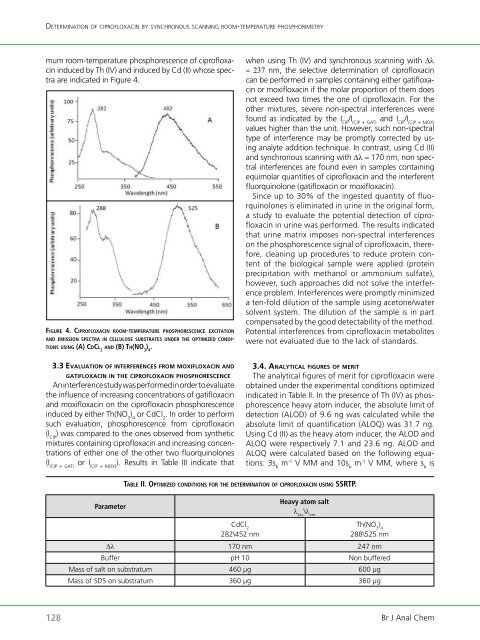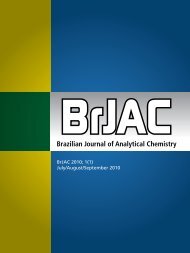Brazilian Journal of Analytical Chemistry - BRJAC - Brazilian Journal ...
Brazilian Journal of Analytical Chemistry - BRJAC - Brazilian Journal ...
Brazilian Journal of Analytical Chemistry - BRJAC - Brazilian Journal ...
You also want an ePaper? Increase the reach of your titles
YUMPU automatically turns print PDFs into web optimized ePapers that Google loves.
determination o f C i p ro f l o x aC i n by s y n C h ro n o u s s C a n n i n g r o o m-temperature phosphorimetry<br />
mum room-temperature phosphorescence <strong>of</strong> cipr<strong>of</strong>loxacin<br />
induced by Th (IV) and induced by Cd (II) whose spectra<br />
are indicated in Figure 4.<br />
fi g u rE 4. Ci P r o f l o x a C i n r o o m-t E m P E ra t u rE PhosPhorEsCEnCE ExCitation<br />
a n d Emission sPECtra in CEllulosE suBstratEs u n d E r t h E oPtimizEd C o n d it<br />
i o n s u s i n g (a) CdCl 2 a n d (B) th(no 3 ) 4 .<br />
3.3 ev a l u a t I o n o f I n t e r f e re n c e s f r o m m o x If l o x a c In a n d<br />
g a t I f l o x a c I n In th e cIp r o f l o x a c In ph o s p h o re s c e n c e<br />
An interference study was performed in order to evaluate<br />
the influence <strong>of</strong> increasing concentrations <strong>of</strong> gatifloxacin<br />
and moxifloxacin on the cipr<strong>of</strong>loxacin phosphorescence<br />
induced by either Th(NO 3 ) 4 or CdCl 2 . In order to perform<br />
such evaluation, phosphorescence from cipr<strong>of</strong>loxacin<br />
(I CIP ) was compared to the ones observed from synthetic<br />
mixtures containing cipr<strong>of</strong>loxacin and increasing concentrations<br />
<strong>of</strong> either one <strong>of</strong> the other two fluorquinolones<br />
(I (CIP + GAT) or I (CIP + MOX) ). Results in Table III indicate that<br />
Parameter<br />
when using Th (IV) and synchronous scanning with ∆λ<br />
= 237 nm, the selective determination <strong>of</strong> cipr<strong>of</strong>loxacin<br />
can be performed in samples containing either gatifloxacin<br />
or moxifloxacin if the molar proportion <strong>of</strong> them does<br />
not exceed two times the one <strong>of</strong> cipr<strong>of</strong>loxacin. For the<br />
other mixtures, severe non-spectral interferences were<br />
found as indicated by the I CIP /I (CIP + GAT) and I CIP /I (CIP + MOX)<br />
values higher than the unit. However, such non-spectral<br />
type <strong>of</strong> interference may be promptly corrected by using<br />
analyte addition technique. In contrast, using Cd (II)<br />
and synchronous scanning with ∆λ = 170 nm, non spectral<br />
interferences are found even in samples containing<br />
equimolar quantities <strong>of</strong> cipr<strong>of</strong>loxacin and the interferent<br />
fluorquinolone (gatifloxacin or moxifloxacin).<br />
Since up to 30% <strong>of</strong> the ingested quantity <strong>of</strong> fluorquinolones<br />
is eliminated in urine in the original form,<br />
a study to evaluate the potential detection <strong>of</strong> cipr<strong>of</strong>loxacin<br />
in urine was performed. The results indicated<br />
that urine matrix imposes non-spectral interferences<br />
on the phosphorescence signal <strong>of</strong> cipr<strong>of</strong>loxacin, therefore,<br />
cleaning up procedures to reduce protein content<br />
<strong>of</strong> the biological sample were applied (protein<br />
precipitation with methanol or ammonium sulfate),<br />
however, such approaches did not solve the interference<br />
problem. Interferences were promptly minimized<br />
a ten-fold dilution <strong>of</strong> the sample using acetone/water<br />
solvent system. The dilution <strong>of</strong> the sample is in part<br />
compensated by the good detectability <strong>of</strong> the method.<br />
Potential interferences from cipr<strong>of</strong>loxacin metabolites<br />
were not evaluated due to the lack <strong>of</strong> standards.<br />
3.4. an a l y t I c a l fI g u r e s <strong>of</strong> me r It<br />
The analytical figures <strong>of</strong> merit for cipr<strong>of</strong>loxacin were<br />
obtained under the experimental conditions optimized<br />
indicated in Table II. In the presence <strong>of</strong> Th (IV) as phosphorescence<br />
heavy atom inducer, the absolute limit <strong>of</strong><br />
detection (ALOD) <strong>of</strong> 9.6 ng was calculated while the<br />
absolute limit <strong>of</strong> quantification (ALOQ) was 31.7 ng.<br />
Using Cd (II) as the heavy atom inducer, the ALOD and<br />
ALOQ were respectively 7.1 and 23.6 ng. ALOD and<br />
ALOQ were calculated based on the following equations:<br />
3s b m -1 V MM and 10s b m -1 V MM, where s b is<br />
taBlE ii. oPtimizEd C o n d i t i o n s f o r thE d E t E r m i n a t i o n o f C iP ro f l o x a C i n u s i n g ssrtP.<br />
CdCl 2<br />
282\452 nm<br />
Heavy atom salt<br />
λ exc \λ em<br />
Th(NO 3 ) 4<br />
288\525 nm<br />
∆λ 170 nm 247 nm<br />
Buffer pH 10 Non buffered<br />
Mass <strong>of</strong> salt on substratum 460 µg 600 µg<br />
Mass <strong>of</strong> SDS on substratum 360 µg 360 µg<br />
128 Br J Anal Chem



